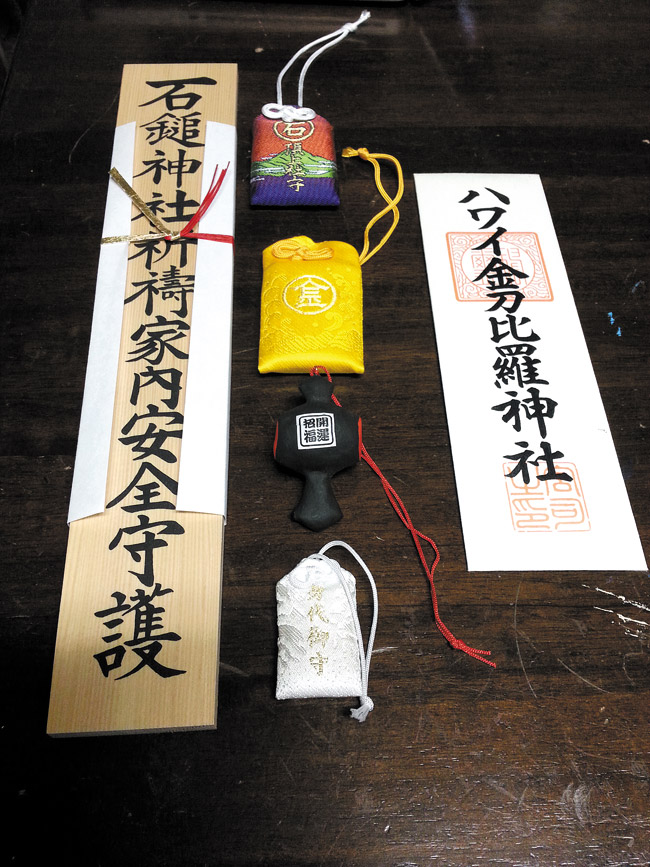Ofuda, Omamori, Faith And Magic
Omamori and ofuda are spiritual charms, talismans and amulets in the Japanese religious tradition that possess the power to ward off misfortune and procure good luck. They can be made of pieces of wood, patches of cloth, strips of paper or rings of metal, and come in various sizes, though the majority found in Hawaii tend to be no larger than the size of one’s palm.
Whereas ofuda are usually placed in a home or business, attached to a wall or door entrance to provide spiritual protection for the entire site, omamori tend to be portable and often can be seen dangling from car rear-view mirrors or pasted on car bumpers and windows, where they are at once expressions of faith and portals of magical power. Omamori also can be worn on the body and, like ofuda, are symbols of protection of the Buddhas and kami. It even is fashionable to attach omamori to handbags, school-bags and cellphones.
Omamori and ofuda often are inscribed with the name of a specific temple or shrine and the particular power or blessing charged to them. Hawaii Kotohira Jinsha-Hawaii Dazaifu Tenmangu is known for its wide selection of omamori and ofuda, many of which are unique to Hawaii. However, omamori and ofuda commonly found at temples and shrines are dedicated to traffic safety, protection from natural disasters, good health, theft prevention and family blessing. Charms to ensure strong and lasting relationships and talismans to help one succeed in school or business also are popular. One may even purchase golf or Las Vegas omamori to help ensure good luck for the wearer. Though omamori represent spiritual power and protection, believers say the benefits they provide are concrete, practical and real.
Different shrines and temples also may have omamori unique to their teaching or practice. Members of Zaoji Temple in Kalihi, for instance, wear snake ring omamori on their fingers. The snake is a manifestation of water or mountain deities, and just as the habitat of the snake crosses the borders between mountain and sea, so too the power of the snake kami is effective in diverse situations.
Another interesting form of spiritual protection is found at Ishizuchi Shrine in Moiliili. During certain rituals, the shrine offers its members paper dolls, which they are to place under their pillows to absorb all the negative energies in their lives. The paper dolls are subsequently burned in a sacred fire to get rid of the bad luck. Dolls purchased and displayed during Girls’ Day may have once served a similar function in Japan.
Omamori represent the magical side to religion. If religion is slow magic, then omamori are quick religion. They provide shortcuts to happiness for the faithful by finding detours around moments of melancholy and anxiety.
I visit churches, temples, mosques, synagogues and shrines on a regular basis, and I find the gods and buddhas quite welcoming and unassuming. (It’s their followers who sometimes are not too pleased with me.) On one occasion a few years ago, a woman at a Buddhist temple in Moiliili smashed her car on her way to the temple’s evening service. As I helped her from her wrecked car to make sure she was OK, several temple followers immediately pointed to the omamori decal pasted on her car and excitedly claimed that this is what had saved her from certain bodily injury. No one questioned why the omamori did not prevent the accident in the first place. Religion always works from the perspective of faith. What mattered most was that the woman suffered no serious physical harm, when in other instances she would have. (Had the woman suffered bodily injury, followers probably would have pointed out that she did not die. Had she died, followers would have then claimed she died in the best way or is now in a better place.)
Omamori, like faith and like magic, always work.
Anyone can buy omamori. Indeed, the serious believer and the casual tourist alike purchase omamori at temples, shrines and department stores. Omamori may function as symbols of salvation or as simply souvenirs, the one creating sacred experiences and the other preserving them.
Omamori create order and preserve meaning where happenstance and misfortune once were. In omamori, the beliefs of followers meet the magic of religion.
Misfitspirit808@gmail.com






